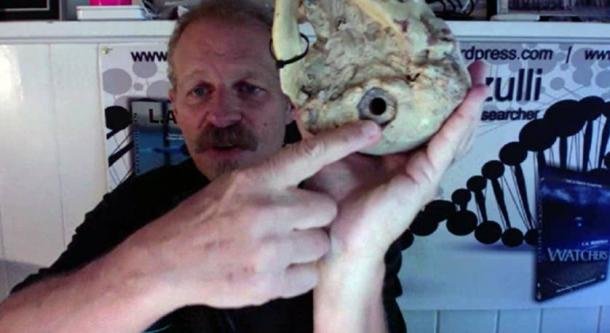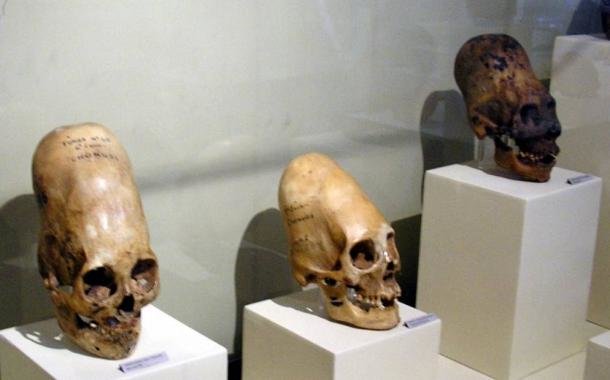Paracas is a desert peninsula located within Pisco Province on the south coast of Peru. It is here where Peruvian archaeologist, Julio Tello, made an amazing discovery in 1928 - a massive and elaborate graveyard containing tombs filled with the remains of individuals with the largest elongated skulls found anywhere in the world. These have come to be known as the 'Paracas skulls'. In total, Tello found more than 300 of these elongated skulls, some of which date back around 3,000 years.
Strange Features of the Paracas Skulls
It is well-known that most cases of skull elongation are the result of cranial deformation, head flattening, or head binding, in which the skull is intentionally deformed by applying force over a long period of time. It is usually achieved by binding the head between two pieces of wood, or binding in cloth. However, while cranial deformation changes the shape of the skull, it does not alter other features that are characteristic of a regular human skull.
In a recent interview with Ancient Origins, author and researcher LA Marzulli describes how some of the Paracas skulls are different to ordinary human skulls:
"There is a possibility that it might have been cradle headboarded, but the reason why I don't think so is because the position of the foramen magnum is back towards the rear of the skull. A normal foramen magnum would be closer to the jaw line..."

"He states that the Paracas skulls, the position of the foramen magnum is completely different than a normal human being, it is also smaller, which lends itself to our theory that this is not cradle headboarding, this is genetic."In addition, Marzulli described how some of the Paracas skulls have a very pronounced zygomatic arch (cheek bone), different eye sockets and no sagittal suture, which is a connective tissue joint between the two parietal bones of the skull.
Continue reading on Ancient Origins.




Reader Comments
It would appear that having a larger skull was no evolutionary survival advantage. Does the DNA indicate that they are not native to this planet?
The elongated skulls of Paracas in Peru caused a stir in 2014 when a geneticist that carried out preliminary DNA testing reported that they have mitochondrial DNA "with mutations unknown in any human, primate, or animal known so far". Now a second round of DNA testing has been completed and the results are just as controversial - the skulls tested, which date back as far as 2,000 years, were shown to have European and Middle Eastern Origin. These surprising results change the known history about how the Americas were populated.
So the first round said that they have some DNA not native to any known human, primate or animal, second round equally as bizarre with the European/ Middle eastern DNA. I had read elsewhere that the skull cavity was at least 25% larger than normal homo sapiens.
I suppose that would give a larger brain and perhaps higher intelligence, but that is just a guess. Perhaps they were unable to mate with our species and that is why they died out. The Egyptian Pharaoh Akhenaten and his line had elongated skulls. Statues of him and his wife show very elongated skulls. He was a weird looking dude as well.
Ask the Cs about this subject.
Akhenaten, Tutankhamun, and their families were SO inbred and for so long, they had an assortment of congenital deformities.
If you consider that times of high cosmic rays would have been responsible for the mutations; that mutations are the basis for evolution and not as Darwin proposed small changes over time, then it is believable.
My favorite mutation is the hammerhead shark. You would think it could not exist or should have died out but the size of the creature offset the drawback of the abnormal eye placement. Every mutation is relative to the creatures placement on the food chain.
I'm reminded of the Tunguska event leading to rh- blood types.
You are spot on. The Darwinian evolutionists are wrong. Catastrophic evolution is the only evolution.
And governments filled with Christian believers, and research institutions funded by Christian believers, have destroyed archaeological evidence and persecuted those who dare to deviate from orthodoxy. From the destruction of the Library of Alexandria to the corruption of the Smithsonian in destroying and suppressing evidence, to the fanaticism of Islamic nutjobs destroying ancient artifacts, for over 2,000 years religious morons have done their utmost to keep humanity in deep ignorance. (Like themselves.)
I have scores of websites bookmarked, which 99.999% of the public have never seen and will never see. Even when I send someone a link and ask them to look at it and comment, they are too busy with their modern "technological" lives to do so. They cannot even find the time to think , much less consider what they should be thinking about. They find the time to culture and look after their bodies, but never try to develop their minds. They are no better than the animals which spend their lives finding food to eat and fucking to reproduce, except that the animals are far more interesting, charming, and beautiful than most humans.